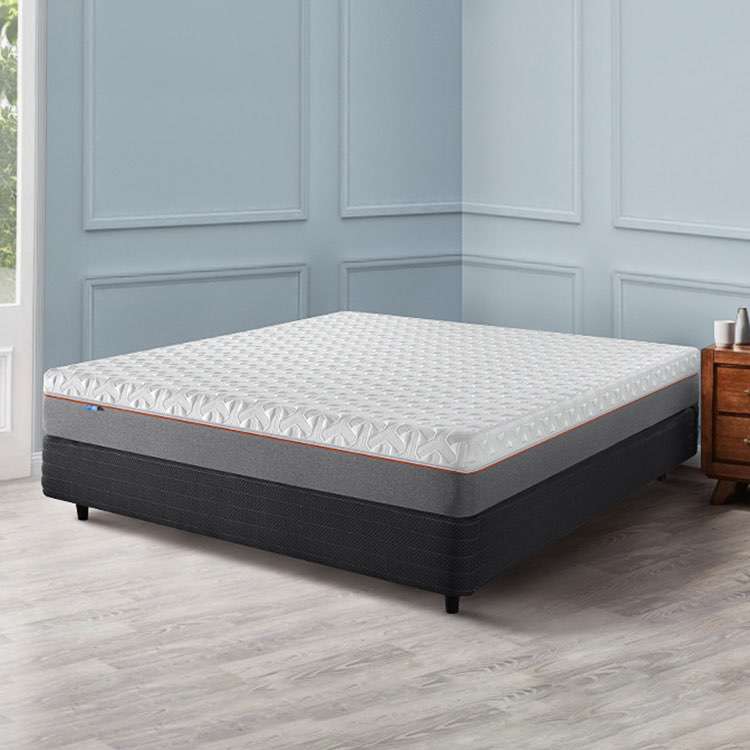How Many Springs In A Good Mattress?
 FOSHAN LEIZI FURNITURE CO., LTD
FOSHAN LEIZI FURNITURE CO., LTD  May 17,2024
May 17,2024
When it comes to unlocking the secret to a truly rejuvenating night's sleep, one often encounters the enigmatic world of spring mattresses. Nestled within their layers lies a network of spring coils, quietly orchestrating the symphony of support and comfort that defines our nightly rest. While these coils may seem like mere components of a mattress, they are, in fact, the cornerstone of its performance. In this exploration, we embark on a quest to demystify the significance of spring count and unravel the intricacies of mattress construction.
Spring coils, the unsung heroes of sleep, provide the essential support needed to cradle our bodies in comfort. Available in various shapes and configurations, from the classic Bonnell coils to the advanced pocketed coils, each type offers a unique blend of resilience and responsiveness. Understanding the role of these coils is crucial in deciphering the language of mattress quality.
Join us as we delve into the heart of spring mattresses, unveiling the secrets behind their construction and the impact of spring count on sleep comfort. By the end of our journey, you'll be equipped with the knowledge needed to navigate the world of mattresses with confidence, ensuring that every night's sleep is a blissful retreat into the realm of dreams.
What are Spring Coils?
Spring coils are the fundamental building blocks of spring mattresses, responsible for providing the support and resilience needed for a comfortable sleep surface. These coils are typically made of high-quality steel wire, meticulously crafted to withstand the rigors of nightly use while maintaining their structural integrity.
There are several types of spring coils commonly used in mattresses, each with its own unique characteristics and benefits. Bonnell coils, the traditional choice, feature an hourglass shape and are interconnected to form a sturdy support system. This classic design offers durability and reliable support, making it a popular option for many mattress manufacturers.
In contrast, pocketed coils, also known as individually wrapped coils, are encased in fabric pockets, allowing each coil to move independently. This design provides better motion isolation, meaning that movement on one side of the mattress is less likely to disturb the other side. This makes pocketed coils an excellent choice for couples or individuals who tend to toss and turn during the night.
Continuous coils are another type of spring coil, featuring a single wire that is formed into rows to create a continuous support system. While continuous coils offer consistent support across the entire mattress surface, they may not provide the same level of contouring as pocketed coils.
Overall, the type of spring coil used in a mattress can greatly impact its performance and comfort. By understanding the characteristics of each type of coil, consumers can make informed decisions when selecting a mattress that meets their individual sleep needs and preferences.
Spring Mattress Construction
Spring mattress construction involves a precise arrangement of spring coils combined with layers of padding materials to achieve the perfect balance of support, comfort, and durability. Manufacturers employ various techniques and configurations to cater to a diverse range of sleep preferences and body types.
The foundation of a spring mattress is its support system, which typically consists of rows of spring coils. These coils may be arranged in different patterns depending on the mattress design. For example, traditional Bonnell coils are often interconnected in rows to create a uniform support surface. Pocketed coils, on the other hand, are individually encased in fabric pockets, allowing each coil to move independently and conform to the body's contours more effectively.
In addition to the support system, spring mattresses feature layers of padding materials that provide cushioning and insulation. These materials, which may include foam, latex, or fiberfill, are strategically placed above the spring coils to enhance comfort and minimize pressure points. The thickness and density of these padding layers can vary depending on the desired level of firmness and plushness.
The top layer of a spring mattress, known as the comfort layer, is often made of softer materials designed to cradle the body and provide initial cushioning. This layer may include memory foam or gel-infused foam to offer additional contouring and temperature regulation.
Finally, the mattress cover, or ticking, encases the entire mattress and provides a protective barrier against dust, dirt, and allergens. High-quality mattress covers are often made of breathable fabrics that promote airflow and help regulate temperature for a cooler, more comfortable sleep environment.
Overall, the construction of a spring mattress is a complex process that requires careful attention to detail and quality craftsmanship. By combining the right combination of spring coils and padding materials, manufacturers can create mattresses that offer optimal support, comfort, and durability for a restful night's sleep. Consumers can choose from a wide range of spring mattress options to find the perfect fit for their individual sleep needs and preferences.
Importance of Spring Count
The spring count, or the number of springs in a mattress, plays a crucial role in determining its ability to provide adequate support, comfort, and durability. Here's why the spring count is important:
Support: The primary function of springs in a mattress is to provide support for the body while distributing weight evenly. A higher spring count typically means more points of contact with the body, resulting in better support. This can help alleviate pressure points, promote proper spinal alignment, and reduce the risk of discomfort or pain during sleep.
Comfort: In addition to support, the spring count also affects the overall comfort of the mattress. A higher spring count often translates to a more responsive and adaptive surface, as the additional coils can better conform to the body's contours. This can result in a more comfortable sleep experience, especially for individuals with specific comfort preferences or who suffer from conditions such as back pain or joint stiffness.
Durability: The number of springs in a mattress can also impact its longevity and durability. A higher spring count generally means more robust construction, as the weight is distributed across a greater number of coils. This can help prevent premature sagging, indentations, and other signs of wear and tear, ensuring that the mattress maintains its shape and performance over time.
Motion Isolation: For couples sharing a bed, the spring count can affect motion isolation, or the ability of the mattress to absorb and minimize movement transfer. Mattresses with a higher spring count, particularly those featuring individually wrapped coils, tend to offer better motion isolation, as each coil can move independently without affecting adjacent coils. This can reduce disturbances caused by a partner's movements during sleep, promoting uninterrupted rest for both individuals.
Overall, the spring count is a critical factor to consider when selecting a mattress, as it directly impacts its support, comfort, durability, and motion isolation capabilities. By choosing a mattress with the appropriate spring count based on individual sleep needs and preferences, consumers can enjoy a more restful and rejuvenating night's sleep.
Finding the Right Spring Count for You
Finding the right spring count for your mattress involves considering several factors to ensure optimal comfort and support. Here's how to determine the ideal spring count for your needs:
Body Weight: Heavier individuals typically require a higher spring count to provide adequate support and prevent sagging. Lighter individuals may find a lower spring count sufficient for comfort without feeling too firm.
Sleeping Position: Your preferred sleeping position can influence the ideal spring count. Side sleepers may benefit from a higher spring count to cushion pressure points, while back or stomach sleepers may prefer a firmer surface with slightly fewer springs.
Personal Preferences: Consider your personal preferences for mattress firmness and feel. Some individuals may prefer a plush, luxurious feel with a higher spring count, while others may prefer a firmer, more supportive surface with a lower spring count.
Trial and Testing: Testing out mattresses in-store or taking advantage of trial periods offered by mattress retailers can help you determine which spring count feels most comfortable for you. Lie down on different mattresses and pay attention to how they feel in various sleeping positions.
Consultation: Seeking advice from sleep experts or mattress professionals can provide valuable insights into selecting the right spring count for your specific needs. They can offer personalized recommendations based on factors such as body type, sleeping habits, and any existing health concerns.
By considering these factors and testing out different mattresses, you can find the perfect spring count that aligns with your individual sleep preferences and ensures a restful night's sleep.
In conclusion, the spring count of a mattress is a critical factor that significantly influences its comfort, support, durability, and overall sleep quality. Understanding the importance of spring count and its relationship to personal preferences and sleeping habits is essential for selecting the perfect mattress.
By delving into the world of spring mattresses and exploring the different types of spring coils, consumers can make informed decisions that align with their specific needs. Whether you prefer a softer, more plush feel or a firmer, more supportive surface, finding the right spring count tailored to your preferences is key to enjoying a restful night's sleep.
When choosing a mattress, consider factors such as body weight, sleeping position, and personal comfort preferences. Testing out mattresses in-store or taking advantage of trial periods offered by retailers can help you determine which spring count feels most comfortable and supportive for your individual needs.
Investing in a quality mattress with the right spring count is an investment in your sleep health and overall well-being. By selecting a mattress that provides the perfect balance of comfort and support, you can wake up feeling refreshed, rejuvenated, and ready to tackle the day ahead.
FAQ
1. What is the ideal spring count for a mattress?
The ideal spring count varies depending on individual factors such as body weight, sleeping position, and personal preferences. Heavier individuals may require a higher spring count for adequate support, while lighter individuals may find a lower spring count sufficient for comfort. It's essential to consider your specific sleep needs and preferences when selecting the right spring count for your mattress.
2. How does spring count affect mattress comfort?
Spring count directly impacts mattress comfort by influencing the level of support and responsiveness. A higher spring count generally results in better support and contouring, as the weight is distributed more evenly across a greater number of coils. This can alleviate pressure points and promote proper spinal alignment for a more comfortable sleep experience.
3. Can I test the spring count of a mattress before purchasing?
Yes, many mattress retailers offer trial periods or allow customers to test mattresses in-store before making a purchase. Lie down on different mattresses and pay attention to how they feel in various sleeping positions to determine which spring count feels most comfortable for you. Additionally, seeking advice from sleep experts or mattress professionals can provide valuable insights into selecting the right spring count based on your specific needs and preferences.











